NEW: Download the updated Conversion Document
and the corresponding Global Code ReadMe.
The function of the program meta-tagging screen is to help us define attributes of each program. This definition will allow us to group programs together within a county to understand services provided to the entire population. Additionally, meta-tagging programs will allow for cross county comparisons to improve client outcomes.
To get to the Program Data Meta-Tagging page, search for “CalMHSA Program Meta Tagging LP”. This will take you to the list page. To add a record for a program, click the “New” icon. This will open up the “CalMHSA Program Meta Tagging Detail”.

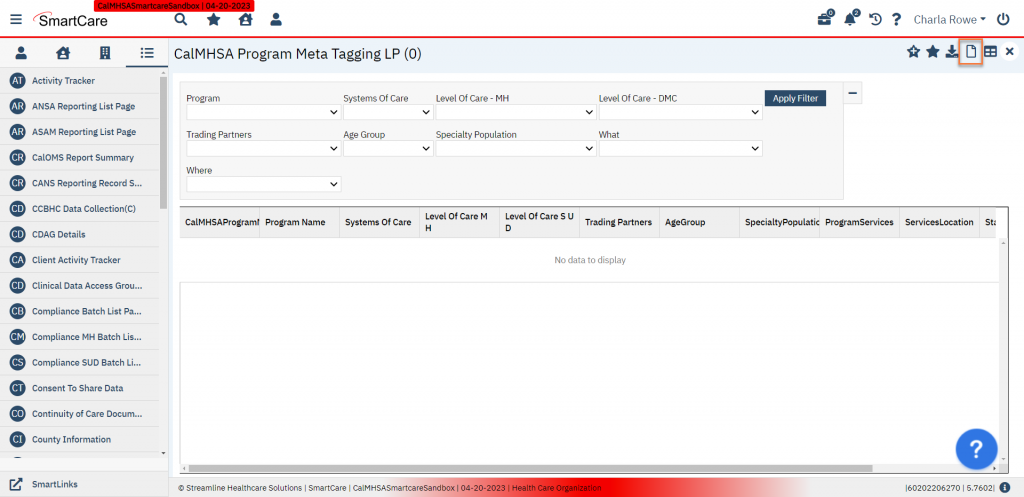

Start and End Date
The start and end date dictionary elements add a date permitter to the program definition. If a county wants to update the program meta-tagging, add an end date, and create a new form with an updated start date.

County or Contractor
This check box defines if the program is either operated by the county or by a separate legal entity —a contractor/community-based organization.

Programs
This is a drop–down menu displaying all programs within the county’s EHR (Electronic Health Record) instance. Use this to select which program you are defining.

System of Care
Dictionary Aim: This dictionary is used to identify the overall System of Care within which the program sits. Mental Health is divided into two systems: Adult and Children’s services. Substance Use Programs are contained within the Substance Use treatment system. Access – which is increasingly integrated to address requests for services in both mental health and substance use programs, is identified as its own System of Care. This dictionary is a single select dictionary.
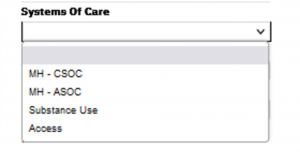
- MH- CSOC: This includes all Children’s System of Care programs.
- MH- ASOC: This includes all Adult System of Care programs.
- Substance Use: This includes all Substance Use treatment programs – regardless of Plan type (includes both DMC-ODS and DMC (Drug Medi Cal) State Plan services) or funding (includes Medi-Cal funding and other relevant funding.)
- Access: This is used for Access to care programs. Typically Access (or intake programs) serve all age groups. These may represent integrated intake centers that assess mental health and substance use conditions and make referrals to treatment services.
NOTE: The System of Care dictionary drives subsequent logic in the Level of Care dictionary. For example, if you select “System of Care = Substance Use,” you will only be able to choose among the ASAM (American Society of Addiction Medicine) levels of care. The System of Care dictionary also drives which Evidence-based practice dictionary is displayed.
Level of Care – MH (Mental Health)
Dictionary Aim: This dictionary is used to identify the general level of care of a mental health program. This dictionary is a single select dictionary.
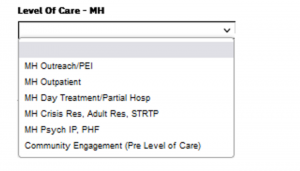
- MH Outreach/PEI
- MH Outpatient
- MH Day Treatment/Partial Hosp
- MH Crisis Res, Adult Res, STRTP
- MH Psych IP/PHF
- Community Engagement (Pre-Level of Care)
Level of Care – DMC
Dictionary Aim: This dictionary is used to identify the general level of care of a substance use treatment program. This dictionary is a single select dictionary.
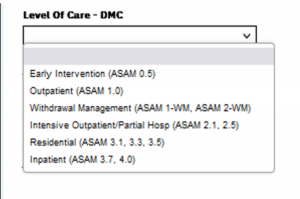
- Early Intervention (ASAM 0.5)
- Outpatient (ASAM 1.0)
- Withdrawal Management (ASAM 1-WM, ASAM 2-WM)
- Intensive Outpatient/Partial Hosp (ASAM 2.1, 2.5)
- Residential (ASAM 3.1, 3.3, 3.5)
- Inpatient (ASAM 3.7, 4.0)
Funding Source
Dictionary Aim: This dictionary is used to capture the funding sources for the program. This dictionary allows you to select multiple items.

- Medi-Cal: The program bills Medi-Cal.
- Medicare: The program bills Medicare.
- Duals (Medi-Medi): The focus of this program is the dual Medi-Cal/Medicare population.
- Managed Care (ECM): This is an Enhanced Care Management (ECM) program. Note that this program would also not be listed as a Medi-Cal program.
- Managed Care (Mild Moderate): A program not part of specialty mental health’s target population. A county would use this when they are under a contractual agreement with a managed care plan to provide services to the mild/moderate population.
- Commercial: Commercial insurance accepted as a key function of the program.
- County – Juvenile Justice: The program is fully or partially funded by county-level juvenile justice funding including youth probation dollars.
- County – Child Welfare: This is used when county child welfare monies fully or partially fund this program.
- County – Other: Select this when the county contributes to the funding of this program, this is generally called “county general funds.”
- County – CalWORKS: CalWORKs fully or partially funds this program.
- County – Probation: County Probation fully or partially funds this program.
- State – Prop 47: County Proposition 47 monies fully or partially fund this program.
- State – AB109: State AB109 monies fully or partially fund to this program.
- State – First 5: First Five dollars fully or partially fund this program.
- MHSA – CSS: Mental Health Services Act, Community Services and Supports (CSS) dollars fully or partially fund this program.
- MHSA – GSD: Mental Health Services Act, General System Development (GSD) dollars fully or partially fund this program.
- MHSA – INN: Mental Health Services Act, Innovation dollars fully or partially fund this program.
- MHSA – PEI: Mental Health Services Act, Prevention and Early Intervention (PEI) dollars fully or partially fund this program.
- Law Enforcement: Other law enforcement funds not identified above fully or partially fund this program.
- Schools/Education: Funding from local school systems fully or partially funds this program.
- Self-Pay Solely: This is used when a program solely serves individuals who are self-paid or uninsured.
- Local County Grant: A local grant, not outlined in the dictionary options above fully or partially funds this program.
- Grant Funded: A statewide or national grant not outlined in the dictionary options above fully or partially funds this program.
- SAMHSA – MHBG: Substance Abuse and Mental Health Services Administration – Community Mental Health Services Block Grant monies fully or partially fund this program.
- SAMHSA – SUBG – Substance Abuse and Mental Health Services Administration, Substance Use Prevention, Treatment, and Recovery Services Block Grant monies fully or partially fund this program.
- Opioid Settlement Funding: Settlement monies supporting opioid remediation activities.
- Prop 30: State funding for non-federal share of new (unfunded) requirements.
- Non-billable to Medi-Cal/Medicare/Insurance
- CARE Act
- FFPSA
Evidence-Based Practices - MH:
Dictionary Aim: The aim of this dictionary is to note if the program has a primary evidence-based practice utilized in mental health programs. If the program does not have one primary or uses multiple, select “other” or “none.” BH-Connect (BHC in the dictionary) refers to EBPs that will be tracked as part of BH-Connect (aka IMD-Waiver Demonstration). This dictionary allows you to select multiple items.

- Assertive Community Treatment (BHC)
- Supportive Housing
- Integrated Dual Diagnosis Treatment
- Illness Management and Recovery
- Therapeutic Foster Care
- Multisystemic Therapy (BHC)
- Functional Family Therapy (BHC)
- Clubhouse Services (BHC)
- Community Defined Evidence Based Practices for SMI/SED (BHC)
- Community Health Worker Services (BHC)
- Coordinated Specialty Care (CSC) for First Episode Psychosis (BHC)
- Forensic Assertive Community Treatment (BHC)
- High-Fidelity Wraparound (BHC)
- Individual Placement and Support (IPS) Model of Supported Employment (BHC)
- Transitional Rent Services (BHC)
- Parent-Child Interaction Therapy (BHC)
- Other Evidence-Based Practice
- No Evidence-Based Practice
- Supportive Employment
- Trauma Focused CBT
Service Strategies - MH
Dictionary Aim: This dictionary is used to capture Service Strategies utilized in mental health programs. This dictionary can be used in lieu of the EBP-MH dictionary above if warranted. This dictionary allows you to select multiple items.

- Peer and or Family Delivered Services
- Psychoeducation
- Family Support
- Supportive Education
- Delivered in Partnership with Law Enforcement
- Delivered in Partnership with Healthcare
- Delivered in Partnership with Social Services
- Delivered in Partnership with Substance Abuse Services
- Integrated Services for Mental Health and Aging
- Integrated Services for Mental Health and Developmental Disability
- Ethnic-Specific Service Strategy
- Age-Specific Service Strategy
- Unknown Service Strategy
Evidence-Based Practices - DMC
This dictionary is only available to DMC programs. Items 1-5 are core Evidence-Based Practices –if the county has implemented DMC-ODS, please select two of those EBPs. BH-Connect (BHC in the dictionary) refers to EBPs that will be tracked as part of BH-Connect (aka IMD-Waiver Demonstration). This dictionary allows you to select multiple items.

- Motivational Interviewing
- Relapse Prevention
- Trauma-Informed Treatment
- Cognitive Behavioral Therapy
- Psychoeducation
- Community Defined Evidence-Based Practices for SUD (Substance Use Disorder) (BHC)
- Community Health Worker Services (BHC)
- Individual Placement and Support (IPS) Model of Supported Employment (BHC)
- Transitional Rent Services (BHC)
- Contingency Management
Primary Trading Partner
Dictionary Aim: This dictionary is used to define which entity (external to behavioral health) that program primarily collaborates with. As we build out interoperability solutions to measure the effectiveness of services, filling out this dictionary will give us a sense of how to prioritize this functionality. This is a single select dictionary.
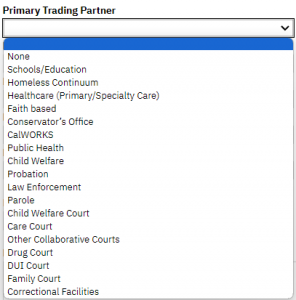
- None
- Schools/Education
- Homeless Continuum
- Healthcare (Primary/Specialty Care)
- Faith based
- Conservator’s Office
- CalWORKS
- Public Health
- Child Welfare
- Probation
- Law Enforcement
- Parole
- Child Welfare Court
- Care Court
- Other Collaborative Courts
- Drug Court
- DUI Court
- Family Court
- Correctional Facilities
Primary Age Group Served
Dictionary Aim: This dictionary is used to identify programs that have an age-based target population. This is a single select dictionary.
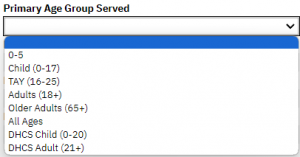
- 0-5
- Child (0-17)
- TAY (16-25)
- Adults (18+)
- Older Adults (65+)
- All Ages
- DHCS Child (0-20)
- DHCS Adult (21+)
Primary Specialty Population Served
Dictionary Aim: The specialty population field is used to capture when a program has a primary target population that is served. This is a single select dictionary.
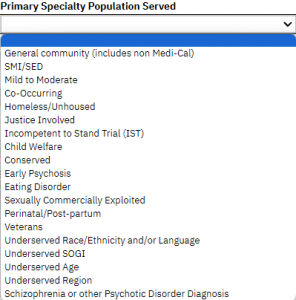
- General community (includes non-Medi-Cal): Select this population if none of the dictionary items below better describes the aim of this program.
- SMI/SED: The program is focused on serving people with severe mental illness or children with severe emotional disturbance.
- Mild to Moderate: The program is focused on services to the mild/moderate population – a population that is currently the responsibility of the non-specialty managed care plans.
- Co-Occurring: The program is focused on providing treatment services to individuals that address both mental health and substance use treatment needs.
- Homeless/Unhoused: The program is focused on services to the homeless or unhoused. This dictionary is only used if this the program’s focus (we can pull homeless individuals served across all programs using client information).
- Justice Involved: The program is focused on providing services to individuals in the justice system.
- Incompetent to Stand Trial (IST): The program is specifically serving individuals who have been declared incompetent to stand trial.
- Child Welfare: The program is focused on services to the child welfare population. This can include the full spectrum of services to families and represent collaborative programs across the spectrum of the reunification process.
- Conserved: The program provides services specifically for the LPS-conserved population.
- Early Psychosis: The program specifically treats the early psychosis population.
- Eating Disorder: The program is focused on treating individuals with an eating disorder.
- Sexually Commercially Exploited: The program is focused on treating individuals who are sexually commercially exploited.
- Perinatal/Post-partum: The program is focused on services to the perinatal and post-partum population.
- Veterans: The program is focused on services to veterans.
- Underserved Race/Ethnicity and/or Language: The program is focused on services to an underserved population as defined by the county.
- Underserved SOGI: The program is focused on services to an underserved population based on sexual orientation or gender identity.
- Underserved Age: The program is focused on services to a specific age group that is underserved.
- Underserved Region: The program is focused on services to a region of the county that is underserved.
- Schizophrenia or other Psychotic Disorder Diagnosis
Primary Program Service Type Provided
Dictionary Aim: The aim of the program services dictionary is to identify the primary types of services available in the program. This dictionary is for mental health and substance use disorder programs. For mental health programs that do not have a specific aim, code the program as option 25 (“Mental Health Services” – outpatient). This is a single select dictionary.
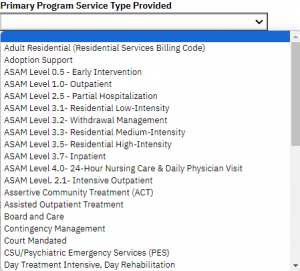
- Adult Residential (Residential Services Billing Code): a program that is operated in a non-institutional residential setting.
- Adoption Support: A program that is focused on the adoption population.
- ASAM Level 0.5 – Early Intervention
- ASAM Level 1.0 – Outpatient
- ASAM Level 2.1 – Intensive Outpatient
- ASAM Level 2.5 – Partial Hospitalization
- ASAM Level 3.1 – Residential Low-Intensity
- ASAM Level 3.2 – Withdrawal Management
- ASAM Level 3.3 – Residential Medium-Intensity
- ASAM Level 3.5 – Residential High-Intensity
- ASAM Level 3.7 – Inpatient
- ASAM Level 4.0 – 24-Hour Nursing Care & Daily Physician Visit
- Assertive Community Treatment (ACT): A program that provides intensive, integrated, evidence-based services in the community to individuals with serious mental illness.
- Assisted Outpatient Treatment: A program that was implemented in response to AB1421, providing court-ordered mental health community treatment for identified adults.
- Board and Care: A facility that is classified as a board and care.
- Contingency Management: Contingency management program meeting the full terms outlined by the state as part of waiver.
- Court Mandated: A program that provides court-ordered services, typically as a condition of an individual’s probation or parole, or as diversion from sentencing.
- CSU/Psychiatric Emergency Services (PES): short term services for individuals to stabilize a mental health crisis and potentially avoid psychiatric hospitalization. Must meet relevant state definitions.
- Day Treatment Intensive, Day Rehabilitation: A program that meets the state definition of day treatment/day rehabilitation.
- Early Intervention: A program focused on detecting and addressing mental health problems as early as possible.
- Enhanced Care Management (ECM): An Enhanced Care Management program funded by managed care plans.
- Full-Service Partnership (FSP): A program that provides comprehensive and intensive mental health supports for individuals with severe mental illness.
- Hospital Diversion: A program with the primary goal of diverting individuals from a psychiatric inpatient setting.
- MAT: Medication Assisted Treatment or Medications for Addiction Treatment
- Mental Health Services (Outpatient Billing Code) without Medication Support: This will be the most commonly used mental health code, standard outpatient mental health services. Use this code if another level of specificity is not relevant.
- Mental Health Services (Outpatient Billing Code) with Medication Support: Standard outpatient mental health services that also includes medication support services.
- Mobile Crisis: Mobile Crisis service meeting criteria outlined by the state.
- Multi-Dimensional Support Center: A program that operates in a setting that provides a variety of services that can include education and employment support, primary care services, housing navigation, etc.
- Peer Run Program: A program that is run by peers — the primary focus of the program is peer run wellness and recovery support.
- Psych Health Facility Services – Psychiatric Health Facility (PHF) services
- Psych Inpatient Hosp Services – Psychiatric Inpatient Hospital services
- Re-Entry Services: A program focused on pre- and post-release needs of justice-involved individuals.
- Recovery/Wellness Center/Clubhouse: A program that primarily provides recovery-oriented services. May involve co-location in a peer run wellness center.
- Reverse Integration Clinic: A program that provides primary care services in a behavioral health setting.
- Short-Term Residential Therapeutic Programs (STRTP): residential facility providing an integrated program of intensive support and services to children/youth, meeting state definitions.
- Sobering Center/Substance Abuse Respite and Engagement: Sobering center or a sobering center like service (many of these have been renamed in recent years) the function of the program is typically jail diversion and engagement with individuals who likely need treatment.
- Supported Housing: A program that provides comprehensive services and case management to assist individuals in maintaining housing.
- Vocational Support: A program focused on supporting individuals with mental illness with obtaining and maintaining competitive employment.
- Withdrawal Management: A program that provides onsite supervision, observation, and support.
- Psychiatric Residential Health Facility (PRHF) Services
- Crisis Only
- Crisis Residential
Primary Service Location
Dictionary Aim: Service location identifies programs that are primarily co-located with a strategic partner. If a program is not co-located with a partner, choose office based. This is a single-select dictionary.
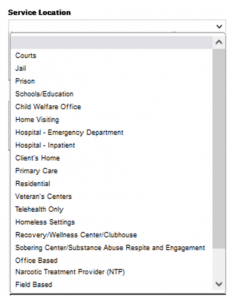
- Courts: A program co-located at a court. Typically involving a collaborative court.
- Jail: A program co-located or primary serving the incarcerated population.
- Prison: A program where outreach is directed towards the prison population.
- Schools/Education: A program co-located in a school setting.
- Child Welfare Office: A program co-located in a child welfare office.
- Home Visiting: A program where the primary function is to provide services in the client’s home.
- Hospital – Emergency Department: A program co-located in an emergency department.
- Hospital – Inpatient: A program co-located in an inpatient program.
- Client’s Home: A program that provides more than 50% of its service time in a client’s home.
- Primary Care: A program that is co-located with primary care providers or in a primary care clinic.
- Residential: A program provided in a residential treatment setting.
- Veteran’s Centers: A program co-located in a veteran’s center.
- Telehealth Only: A program that solely provides services via telehealth.
- Homeless Settings: A program focused on individuals who are unhoused and primarily provides services in settings such as homeless encampments, homeless shelters, etc.
- Recovery/Wellness Center/Clubhouse: A program that is focused on wellness services, often peer run.
- Sobering Center/Substance Abuse Respite and Engagement: A sobering center or early engagement facility for individuals likely needing substance abuse treatment.
- Office Based: A program that provides services in the office at least 50% of the time.
- Narcotic Treatment Provider (NTP): A program that provides Medications for Opioid Use Disorder.
- Field Based: A program that provides services in the field. A program meeting this definition would have greater than 50% of services provided outside of the office.
- Juvenile Hall: A program co-located in or primarily serving individuals in Juvenile Hall.
- Urgent Care: A program co-located in an Urgent Care facility.
Feel like we missed something? Provide feedback on the data dictionaries used by completing a survey here: https://www.surveymonkey.com/r/WQT3KJT
Updated 5/30/24
